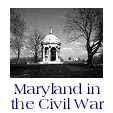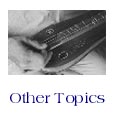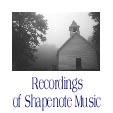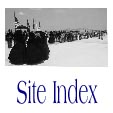


The perfect setting for a Sacred Harp Singing. Photo by John Lamb
by John Lamb
A gentle breeze blew in from the mountains on a sweltering August day, as an elderly gentleman walked to the center of the square formed by singers in the plain country church. Opening an oblong-shaped hymn book, he said "Let's look at number 155 -Northfield." A singer sang the pitch of the first note, and they were off. But syllables, names for the notes, filled the air instead of notes. When they had sung the "names" of the notes, they returned for the words: "How long, dear Savior, o how long shall this bright hour delay?" The parts entered in turn and the words resounded off the walls and rough-hewn pews, out the open windows, into the woods beyond.In countless churches and halls throughout the South, on days ordained by formulas like the "Saturday before the 4th Sunday," this scene is repeated as the faithful gather to sing from the Sacred Harp. They have come to raise their voices in song to God, and in doing so they form a bridge between us, and our past. Though the roots of their way of singing can be traced to 18th century England, it is a uniquely American institution.
As church leaders in New England in the 1700s looked for a way to improve congregational singing, the idea of teaching singing schools was developed. Traveling singing school masters taught the children of entire towns how to read music and sing. As the demand for new music increased, the singing masters compiled tunebooks of songs they had written or arranged.
Tunebook compilers later developed sets of "Patent" or "Shape" notes to help singers learn to read musical notation. The shapes convey the location of the note in the scale. In the brightest days of shapenote singing in America, numerous tunebooks competed for singer's attention. But as American musical culture fell under the sway of European art music in the mid-19th century, singing from shapenote books dwindled and died out in the North.
People in the rural South continued to sing from their beloved old shapenote books, in three or four part harmony. Periodically they would revise the books, adding new songs and taking out those that had not gained favor. The Sacred Harp, first published in 1844 and revised numerous times since, continues to be the basis of the strongest remaining shapenote singing tradition.
Sacred Harp singing was "discovered" by scholars of folk music in the 1920s and 1930s, and several prominent books awakened interest in the music. Since then, Sacred Harp singing has spread again throughout the North, into the midwest to California, Washington, Hawaii, and internationally, to England. Sacred Harp singers are a diverse group of people, drawn from the ranks of a number of religious denominations and from varied economic backgrounds, united by their love for the style of music found in the Sacred Harp and the rich social traditions associated with it.
If there are any clear difference between them, it is how they become involved with the tradition. "I first heard it live at a music festival in Wisconsin," said Dick Dunagan, a Sacred Harp singer from Wisconsin. "It caught my attention and I liked it right away." Dunagan and his wife began to sing with a group of singers in their area. And then, the traveling began. "We began to go South to see how it is sung there." Raised in a small country church, the singings began to feel like homecomings, noted Dunagan.
For many like Dunagan, shapenote singing was something happened upon at a folk festival, through a by a chance snippet on a folk music radio program or a different sounding track on a CD.
But for others Sacred Harp singing is organic. "I was born into it," said Richard DeLong, a high school teacher, and singing school master from Carrollton, Georgia. "Grandmother carried me to my first singing." Like other Sacred Harp singers, DeLong feels strongly drawn to the music and the tradition. "I find Sacred Harp addicting, for a number of reasons," said DeLong, "The more you go, the more you want to go." The most powerful pull is the spirituality of the singing. "I couldn't think of anything more spiritual than Sacred Harp," said DeLong.
DeLong's feelings are shared Sacred Harp singers across the country. To see a church filled with people singing in four part harmony with energetic roof raising volume is a powerful experience, which for many singers transcends into worship. "Singing is the way that I worship the Lord," said Rodney Ivey, a member of a well-known family of traditional Sacred Harp singers from Northwest Alabama. "I get more from singing than I do from preaching."
Singers also become part of a large and growing community. "It is really like an extended family," said DeLong. Whether through staying in each other's homes while attending singings, traveling together across the country to sing, or even using the Internet, singers develop lasting friendships. They share each others struggles and losses. Many singings include a special "memorial lesson" where the names of those who have died are called, and a song sung in their memory. The sick are remembered as well.
The constant addition of new converts to this beloved tradition, does not diminish the pain when singing friends die. "Old traditional singers are disappearing," said DeLong, "They are not being replaced as fast as they disappear-not that we can ever really replace them." It is not a mystical experience that causes Sacred Harp singers to speak of "singing with those who have gone before," but more of a feeling of continuity -- those who have gone live on in the thoughts and memories of their fellow singers through the music they loved.
"As I look around, I always see about the same number of people," said DeLong. "More people come in to fill the spots, but we never replace anyone. If all the singers {who have been} could just be here there would be no place big enough to hold us!" Celebrating those who have gone before, but looking ahead, Sacred Harp singing is poised to enter the new millennium aided by modern technology. An Internet mailing list allows singers to announce singings, share prayer requests, and even recipes. A detailed website contains information about locations of singings, books, recordings, and how-to information.
In communities around the South and throughout the country, including Chattanooga, Sacred Harp singing continues to provide people with a way to socialize, and to worship, as it has for their ancestors for more than three generations. Find a Sacred Harp singing and get to see early American culture in action, in an MTV world.

| 
| 
| 
| 
|